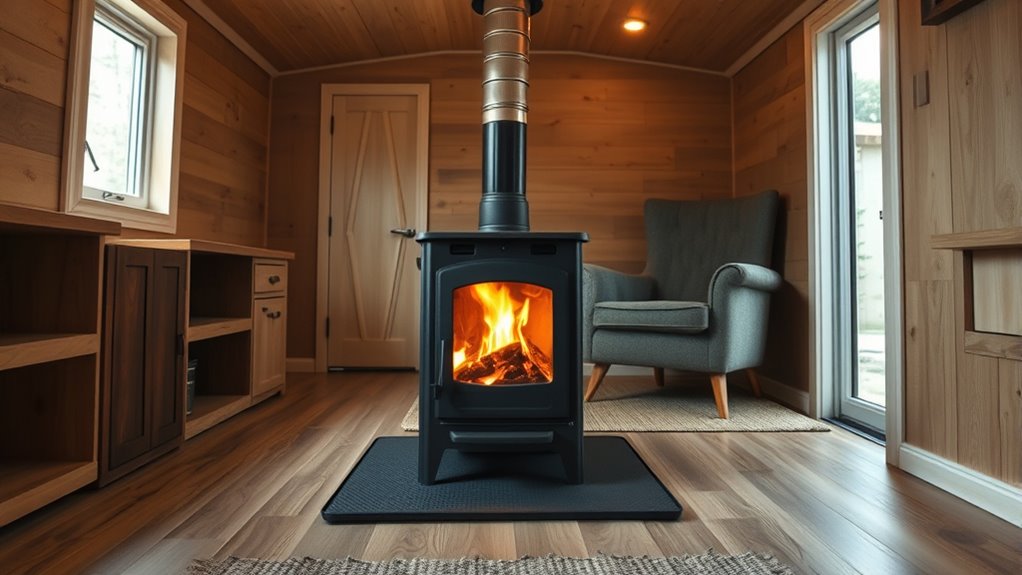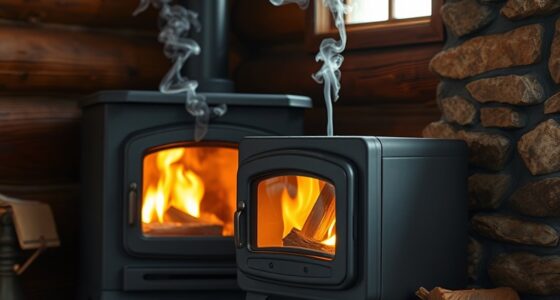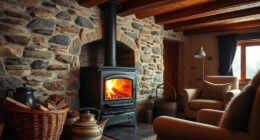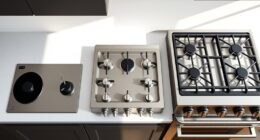Yes, you can install a wood stove in a mobile home or tiny house, but you must follow strict safety guidelines, local building codes, and proper venting procedures. Make certain the stove is correctly vented with a chimney or stovepipe designed for mobile applications, and keep the proper clearances from combustibles. Using safety features like heat shields and consulting professionals can help you install it safely. If you want to learn more about safe installation practices, keep going.
Key Takeaways
- Check local building codes and manufacturer instructions for mobile or tiny house stove installation requirements.
- Ensure proper venting systems are installed to direct smoke outside and prevent dangerous fumes buildup.
- Maintain appropriate clearances from combustible materials and install hearth protections per safety standards.
- Use certified vent pipes, sturdy bases, and safety features like shut-off mechanisms for safe operation.
- Consult local authorities and professionals to ensure compliance and proper installation in your specific mobile or tiny house.

Installing a wood stove in your mobile home or tiny house is a practical way to add warmth and reduce heating costs, but it requires careful planning and adherence to safety standards. One of the most critical aspects is ensuring proper ventilation requirements. Adequate ventilation isn’t just about comfort—it’s essential for maintaining indoor air quality and preventing dangerous buildup of smoke or carbon monoxide. You’ll need to check that your installation meets local building codes and manufacturer instructions, which specify minimum clearances, venting methods, and airflow needs. Proper ventilation also involves installing the right type of chimney or stovepipe that’s designed for mobile or tiny house applications, ensuring it efficiently directs smoke outside and minimizes the risk of leaks or blockages.
Equally important are fire safety codes, which set the foundation for a safe installation. These codes dictate how far your stove must be placed from combustible materials, the types of hearth protection required, and the proper clearance space around the unit. Ignoring these standards can lead to accidental fires, which are especially devastating in mobile homes and tiny houses where space is limited. You’ll also want to ensure your stove has appropriate safety features, such as a sturdy base, heat shields, and a reliable shut-off mechanism. When installing, always double-check that your setup complies with local fire safety codes, which might vary by jurisdiction but share common principles aimed at preventing fire hazards.
Before you begin, consult both local building authorities and the stove manufacturer’s guidelines. This step helps you understand specific ventilation requirements and fire safety standards applicable in your area. If you’re unsure, working with a professional installer can save you from costly mistakes and potential safety hazards. Remember, ventilation isn’t just about vent pipes; it also involves ensuring your space has enough fresh air intake and exhaust to maintain safe oxygen levels. Properly installed, your wood stove not only provides cozy heat but also operates efficiently and safely, giving you peace of mind. Additionally, understanding the importance of proper ventilation can significantly improve the overall safety and efficiency of your heating system.
Frequently Asked Questions
Are There Specific Wood Stove Models Suitable for Mobile Homes or Tiny Houses?
Yes, you can find specific wood stove models suitable for mobile homes or tiny houses. Look for units with a compact design that fits limited spaces and offers adjustable heat output to maintain comfort without overheating. Choose models that meet safety standards for mobile environments and are easy to install. These stoves provide efficient warmth, ensuring you stay cozy while maximizing space and safety in your small living area.
How Does Installing a Wood Stove Affect Mobile Home Insurance Policies?
Installing a wood stove can throw a wrench in your insurance considerations, as it often requires policy modifications. You might need to notify your insurer, and your premium could go up due to increased fire risk. Some policies may even exclude coverage for wood stove-related damages. Always check with your insurer first to avoid surprises later on, and verify your installation meets safety standards to keep your coverage intact.
What Are the Ventilation Requirements for Safe Wood Stove Operation?
You need proper ventilation methods and airflow considerations for safe wood stove operation. Guarantee there’s adequate air intake to support combustion and prevent buildup of dangerous gases. Use a chimney or vent pipe designed for your stove, and keep it clear of obstructions. Install carbon monoxide detectors and follow local building codes. Proper ventilation reduces health risks and fire hazards, making your tiny house or mobile home safer and more efficient for wood stove use.
Can I Install a Wood Stove Myself, or Should I Hire a Professional?
You might think you can handle a DIY installation, but don’t be so sure. Installing a wood stove requires understanding ventilation, clearance, and safety codes—things best left to a professional. Skipping expert help could lead to hazards or code violations. So, while it’s tempting to do it yourself, hiring a professional guarantees your setup is safe, compliant, and efficient. Trust the experts for peace of mind.
What Are the Zoning or Legal Restrictions for Wood Stove Installation in Tiny Homes?
You need to check local zoning restrictions and obtain any necessary legal permits before installing a wood stove in your tiny home. Regulations vary widely by area, and some zones may prohibit indoor wood burning for safety or environmental reasons. Always consult your local building department to guarantee compliance, and follow all permits and codes to avoid fines or safety issues. This way, you can enjoy your wood stove legally and safely.
Conclusion
So, yes, you can install a wood stove in your mobile home or tiny house, blending warmth with rustic charm. But remember, safety should always come first—like the steady glow of a fire in a safe hearth, carefully maintained. While the cozy heat offers comfort, neglecting proper installation or ventilation can turn that same warmth into danger. Embrace the balance of rustic beauty and responsible planning, ensuring your tiny retreat remains both inviting and safe.











